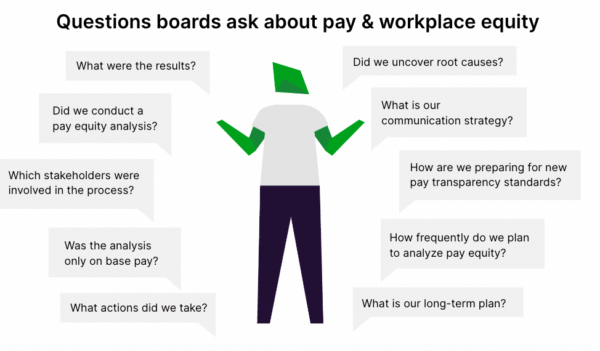With the rise of shareholder proposals for greater disclosures on pay and pay gaps, the Great Resignation, rising labor costs, and environmental, social, and governance (ESG) reporting, the role of the board is expanding. In the past, boards were tightly focused on delivering value to shareholders. While that is still a priority, The Future of the American Board Report: A Framework for Governing into the Future from the National Association of Corporate Directors (NACD) discussed how boards are broadening the lens by which they view “stakeholders” to include employees, customers, and the community in which the company does business.
Alongside this heightened accountability for boards to consider “people” interests as a strategic imperative, a new hot spot of attention is emerging for board oversight around equitable workplace outcomes, i.e. workplace equity. The NACD report states, “As the labor market evolves and employees look for more from their workplace than just compensation, workforce satisfaction and engagement are key topics for board focus,” as well as “a rational and equitable approach to compensation.”
In today’s tight labor market and volatile economy, the ability to attract, retain, and keep top talent engaged is a competitive advantage and critical to long-term success. 58% of employees (and 70% of Gen Z employees) would consider leaving their current job for more pay transparency. Workplace equity is also important for risk mitigation in the face of expanding pay scale transparency legislation and pay gap reporting requirements.
While it’s clear that boards are increasingly interested in these topics, what’s the best way to present your workplace equity strategy and progress to them? Our recent webinar, How to Communicate About Workplace Equity to Your Board, shared advice about how to effectively involve board members in discussions about workplace equity to get their buy-in. Featured speakers included:
- Orlando Ashford, Syndio Board Member & former HR Leader
- Chris Taylor, VP, Head of Listings & Services at NYSE
- Nancy Romanyshyn, Director of Pay Strategy and Partner Success at Syndio
- Moderator, Katie Bardaro, Chief Revenue Officer at Syndio
Below we highlight some of their top tips for communicating with your board about workplace equity.
5 tips to prepare for board conversations about workplace equity
1. Gather requirements.
First and foremost, do your due diligence to outline what your board should know about workplace equity. What are the top-of-mind risks related to the workplace? Is your company required to comply with new legislative requirements for pay scale transparency or pay gap reporting? Is pay equity a pain point, or lack of leadership diversity?
Be thorough about answering how you’re currently tackling the issue as well as “what’s next” for your long-term plan. There are a lot of questions that your board might fire at you, so try to anticipate them by asking yourself and your team these questions ahead of time.
2. Cover your findings with data.
“I think where we’ve evolved is there has been this transition where boards are asking more questions and asking for more specifics — what are the metrics? What are we measuring? How do we look compared to others in our industry who we’re competing with for talent?” – Nancy Romanyshyn
It’s crucial to back up your narrative with clear metrics across comparable groups. Workplace equity metrics speak to the health of your organization and the outcomes of how you treat your people: your culture, employee engagement, diversity, inclusion, representation, and movement. Pay equity is a common starting point for many organizations to tackle because it’s easy to measure and closely scrutinized. However, pay gaps themselves are not only about pay, but are deeply rooted in earning opportunities and career advancement through the organization.
Common workplace equity metrics to share with boards include:
- The results of pay equity analyses
- Employee representation across functions and levels showing how your organization looks today, how it should it look, and how representation is trending over time (i.e., “opportunity equity”)
- Unadjusted pay gaps (i.e., the average pay for one employee demographic compared to another)
- Adjusted pay gap (i.e., “equal pay for equal work,” which means pay gaps that persist after accounting for similarities in jobs)
Be sure to share the methodology you used to measure any metrics. You must also be committed to ongoing measurement because the board is going to continue to ask about where the organization stands and you need to be able to show progress over time. When reporting out to the board, transition from a backward-looking point-in-time audit to an ongoing narrative that shows “here’s what we are proactively doing about this.” It can also be helpful to share what other leading companies (especially those you compete with for talent) are doing around workplace equity.
3. Translate for your audience.
“Provide a visual that creates the emotion and energy to give you space to present the story of how you’re going to fix problems with analyses, tools, and resources.” – Orlando Ashford
Boards are made up of leaders with varying areas of business expertise, so it’s important to translate your metrics for a broad audience. Identify other influencers in your organization who have familiarity with the board who can help you prepare your messaging. They’ll be able to help you identify what will be of greatest interest to the board so you can refine your story, tie your narrative to business concerns, and select the most high-impact data points. Syndio’s team of expert advisors can support a strategy session for crafting workplace equity narratives.
Present your metrics in a visually accessible way. Visually representing disparities in pay, promotions, retention, and other employee outcomes can create the gut-punch feeling in the audience that “this isn’t right”, which gives you the emotional space you need to then dive into details of the why and how.
In the webinar, Orlando provided an example from when he was an HR leader and would create a visual that stack-ranked pay. He would start at the top and then point out how far down the list it would take to reach the first woman (or other employee identity group), which was an emotionally powerful visual for his audience.
4. Walk through an actionable plan.
“‘Workplace equity’ is a word that makes boards nervous. No company wants to have workplace inequity, but to know that, you have to track, you have to measure, you have to investigate. If there’s a problem, be clear on what’s the plan to track those issues and what’s the plan to mitigate.” – Orlando Ashford
Of course, every board wants to hear that the company is doing well and that there are no inequities (and therefore fewer risks). But the reality is that nearly every company that starts measuring and tackling workplace equity is going to uncover some hard truths. But as Nancy shared, communicating with the board about the state of workplace equity at your company is about building trust by being honest and open.
Doing a “full body scan” of workplace equity at the organization is crucial to be able to flag and diagnose problems and then create an action plan to correct them. Bring this conversation back to values — if your company truly believes in equity and treating your people right, then you must commit to repeating the process over and over again over time in order to achieve progress.
You don’t want to just talk about a big conceptual problem (e.g. “We have pay inequities”) and leave it at that. You must pair the problem you’ve identified with a story of how you’re going to fix it. Share specific, measurable, data-driven goals and a clear timeline for your workplace equity action plan that outlines what you’ll deliver and when. Always tie long-term commitments back to core business goals and priorities.
5. Use meaningful moments to shore up your “why.”
“The mindset of the employee has changed and that’s being reflected now in the way companies react to the current [economic] situation. Many companies may be slowing hiring but not laying off because retention is so important and it’s hard to find good people. The broader issue of equity has to continue to be a focus for companies.” – Chris Taylor
The current macroenvironment is turbulent. A continued tight labor market paired with the possibility of a recession is creating unique compensation and talent management challenges. But moments of uncertainty are also moments of opportunity.
As Orlando said in the webinar, “You never want to waste a good crisis.” A crisis environment helps clarify what the company really needs and HR issues have the same implication for the business as logistical problems such as supply chain issues.
Nancy pointed to the lessons learned from our last enormous crisis — the COVID-19 pandemic — which demonstrated that people deliver long-term value. Companies who treat, engage, and hold on to their employees equitably will have an advantage in good times and bad. As leadership questions how to cultivate talent in this market, workplace equity provides an avenue for your company to differentiate and move ahead of competitors.
Additionally, there are rising demands from legislators, regulators, employees, and consumers for companies to be more transparent and increase disclosures around metrics such as pay equity, pay gaps, salary ranges, and other human capital metrics. For example, the Working Group on Human Capital Accounting Disclosure has petitioned the SEC to expand disclosure around human capital metrics, which is on the SEC’s Reg-Flex agenda for consideration. All of these pressures are building to what amounts to a mandate for companies to continue to prioritize workplace equity no matter the economic environment.
Board composition matters in workplace equity, too
“The composition of the board speaks volumes to a company’s employees and customers.” – Chris Taylor
Not only should boards care about workplace equity progress, the composition of a company’s board should be held to the same equitable representation standards as the rest of the organization. If your company has a diverse C-Suite but your board composition is not reflective of your employee and customer bases, any commitments to “equitable leadership representation” will feel hollow and send the wrong message to your workforce and the public.
A diverse board is also a source for greater innovation due to a wider range of perspectives and experiences. As Orlando put it, “A board is simply a set of talented executives who have insights who can help lead the business better and provide advice and counsel to help the business. By having people with different backgrounds [on your board], you have access to more robust and diverse ideas.”
There is growing regulatory pressure for board diversity, such as the new EU directive that will require that 40% of boards and non-executive directors be members of “the underrepresented gender.” But Chris shared that the pressure for a diverse board isn’t just coming from regulations, but rather, the real pressure point is that it’s a necessity to be a successful company. To address the critical need for diverse, inclusive leadership on company boards, the NYSE Board Advisory Council leverages its network of CEOs from some of the world’s largest and most well-known companies to identify and nominate board-ready candidates.
Communicate with confidence using data-backed insights
Michael Blaugrund, NYSE’s Chief Operating Officer shares in this Bloomberg article, “The social element of ESG has been harder to support and is often less defined for companies, but [is] an area of increasing focus at the board level, among employees, and with legislatures and regulators. Having the tools to better measure and understand their workplace equity issues is going to increasingly become table stakes.” NYSE has partnered with Syndio to provide NYSE-listed companies with purpose-built solutions to measure their pay and opportunity gaps.
These were only a few highlights from the full conversation with Orlando, Nancy, and Chris. Watch the on-demand webinar recording at the link below for more advice on discussing workplace equity with your board. You can also find additional resources for communicating about workplace equity initiatives and progress to a range of stakeholders, including boards, employees, and the public at the links below.



